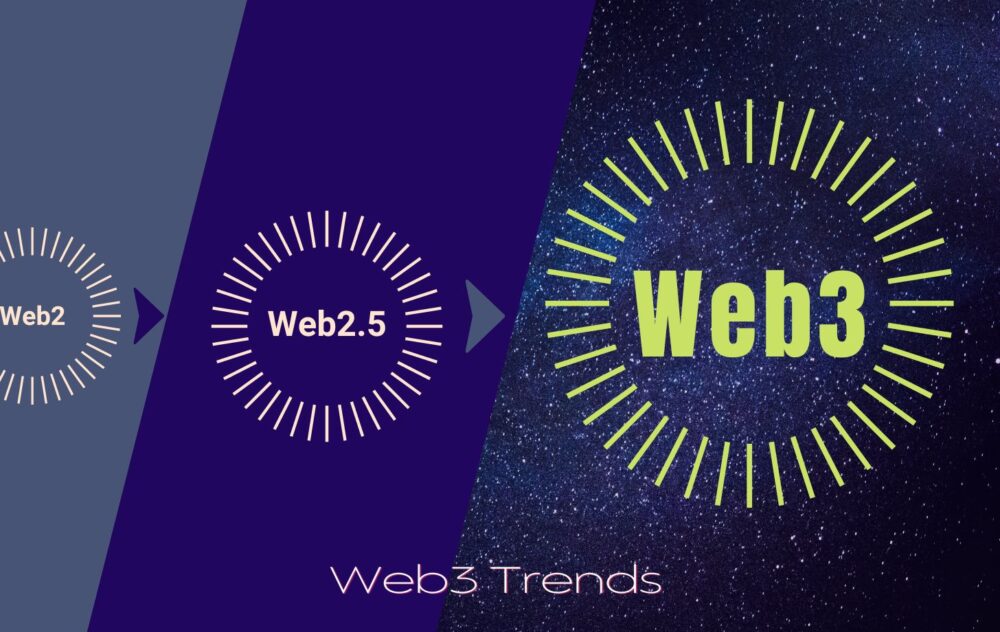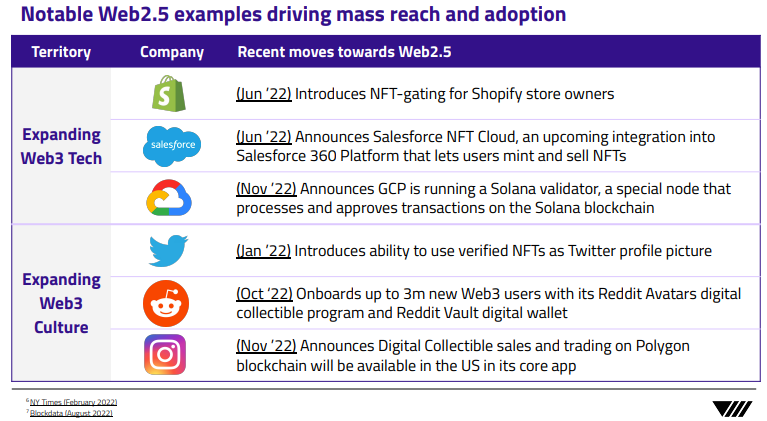Both users and businesses must continue learning about Web3 technology trends today because the Web3 industry is expanding rapidly.
There has never been a better time to study Web3 development, with so many immersive, user-friendly, and fascinating decentralized applications becoming available. In the digital age, being a web developer can lead to a variety of job and company options.
Therefore, the main goal of Web3 is to return internet power to users rather than corporations. Web 3 uses blockchain and cryptocurrency technology to create a kind of ownership to do.
In terms of your keen interest to take benefits from the top trending web3 technologies, here are those, I'm keen to share with you.
The Top 10 Web3 Technology Trends
Staying on top of new and upcoming technologies is essential for any organization, but in the world of Web3, trends can change quickly.
From blockchain-powered smart contracts to the rise of decentralized applications, these 10 Web3 Technology Trends will be the most influential in 2023. Keep reading to stay ahead of the curve!
1. Decentralized Technology
Decentralized technology is creating a buzz in the tech world. Decentralization seeks to return control of data to users and away from centralized storage like cloud vendors and institutions.
Decentralization relies on distributed peer-to-peer (P2P) technology principles, allowing for a more equitable sharing of data and services across networks without centralized actors or points of failure.
With the advent of Web 3.0, companies can run business models that enable the following functions with data privacy and permissions management:
(1) direct user monetization,
(2) microtargeting of users,
(3) automation of processes using Blockchain security protocols, and,
(4) resolution of several long-standing issues.
We are now seeing the development of decentralized ad networks that bring a higher level of transparency to digital advertising campaigns by giving advertisers access to more reliable analytics stemming from P2P data-sharing protocols that eliminate pre-authorized intermediaries.
We are also seeing the democratization of enterprise software with blockchain technology. It provides better governance structures such as permission models related to data access to protect personal information in ways not previously available.
Blockchain also provides verifiable records across multiple sources thus diminishing fraud risk through verified distribution systems (smart contracts).
Decentralized communication between IoT/devices is being enabled as well via next-generation low-level protocol abstractions such as WhatsApp’s Libra Protocol Graph.
Extension tools put clients first with peer-direct capabilities which allow devices or people on different networks through automatic switching between public keys so messages are securely sent without additional setup costs or manual confirmation steps for the sender(s).
Overall, these applications can provide makers with an opportunity to empower users (or peers) by offering secure authentication, security tools/products as well as outreach strategies.
It helps to develop new monetization capabilities for firms rolling out through dynamic ecosystems along with increased consumer democracy.
Also, it gives secure access to additional control over their digital interactions amidst new levels of trust and transparency via tech advances in web3 trends throughout 2023.
2. Artificial Intelligence (AI)
Artificial Intelligence (AI) is here to stay, especially in the web3 technology trends. AI plays an integral role in the development of web3 technologies such as blockchain and machine learning.
These technologies are being applied to create innovative solutions that tackle different problems, from financial services to global security. Developers are now leveraging AI-based approaches to solve complex problems rapidly and efficiently in an ever-evolving digital landscape.
In addition, deep learning has enabled machines to develop sophisticated algorithms for recognizing patterns and understanding human behaviors on a deeper level.
Combining deep learning and other AI techniques with blockchain technology have opened up new possibilities for application development within the business sector.
For example, predictive analytics can be used to identify potential customer groups or target specific audiences within a given market or industry segment with customized offerings. This in turn can drive customer loyalty and engagement significantly.
Another benefit of using AI in web3 technologies is enhanced cyber security measures through improved identity management and fraud prevention capabilities.
AI-enabled solutions can detect malicious activities more accurately compared with traditional methods due to their ability to recognize patterns quickly and accurately amongst larger datasets of data points or user interactions on the platform.
This helps organizations reduce costs associated with cyber-attacks while providing better overall product experiences for customers.
3. Brands As A Service (BAAS)
Brands As A Service (BAAS) is an emerging trend that many businesses are turning to build and reshape their digital presence. BAAS is essentially a B2B platform that merchants can use to spread their brand, services, or products more widely across the web.
Through BAAS, merchants can set aside a certain amount of money each month and use it to create brand awareness and acquire customers.
BAAS helps businesses tailor their engagement for different audiences, get feedback from potential customers, and find out which features their customers value the most.
Merchants could also target specific demographics through search engine optimization (SEO), targeted advertising campaigns, display ads, email campaigns, and sponsored content on various social media platforms.
Additionally, merchants can get insights into customer behavior by analyzing customer data metrics collected via analytics platforms such as Google Analytics.
The main benefits of BAAS include a quicker time-to-market for innovative products or services, lower marketing campaign costs, automation of some marketing activities, and increased scalability.
Also includes improved customer retention, guaranteed ROI, higher customer satisfaction, improved brand representation across multiple digital channels, and better targeting of the right audience.
As a result of the ability to focus more on user experience than just tech infrastructure, BAAS is quickly evolving into a "must-have" technology tool for contemporary businesses looking to redefine what it means "to be digital" in the 2020s.
This concept includes not only software development but also marketing initiatives and operations optimization.
4. 3D Web Technology Interaction
The 3D Web is beginning to revolutionize the way people interact with information, applications, and each other over the internet. 3D technology gives us the ability to explore digital objects in a more immersive and interactive way.
This includes applications such as medical education and healthcare, engineering, architecture, games, business development, and visualization — among so many others.
Web3 technology allows users to see 3-dimensional representations of data in a natural environment within web browsers or standalone apps on desktops and mobiles.
Through this technology, innovations are being made in gaming consoles as well as Virtual reality (VR) systems. We can now move beyond 2D applications with immersive 3D simulations that give us more detailed viewing options from any angle.
With advancements in graphics processing speed and computing power, we now have access to even more realistic images that take into account shadows and reflections for an even better user experience.
Thanks to faster Ethernet speeds people can experience events faster than ever by participating remotely in real-time activities anywhere around the world with minimal lag times.
Additionally, we are also seeing advances in voice-controlled software that interacts with 3D web technologies including Voice User Interfaces (VUIs) which allow interaction through natural speech commands rather than physical device interaction such as keyboards or touch screens.
In addition, Web3 technology also allows us to interact with others throughout the world with shared virtual whiteboards and conferencing sessions that enable workflows across remote teams on desktops or mobile devices.
It's been leading to improved collaborations between far-away clients and colleagues alike – making cross-border communication a breeze!
5. Decentralized Metaverse
By 2023, we may see a decentralized metaverse platform and immersive internet environment that goes beyond a social network of online user profiles.
The concept of the metaverse has been studied for many years, but only recently have technologies matured enough for its creation.
The decentralized metaverse, one of the remarkable partner in web3 technology trends, can be defined as a collective virtual space with its economy, laws, and platforms. It refers to the digital world where several users will interact and co-exist simultaneously.
The idea of a decentralized metaverse allows developers to build cross-platform, shareable applications and data sets that can be used across different operating systems without being locked into any one particular platform or approach.
This could enable people to create virtual representations of themselves alongside various kinds of communication such as text chats, video conferencing, and 3D project collaboration tools.
Virtual worlds could extend beyond gaming and entertainment scenarios by including educational activities such as online classrooms and personalized learning experiences which can scale up or down in complexity depending on user ability levels.
Decentralized metaverses would be made up of distributed software components created by different developers around the world.
They are free to develop their solutions based on common standards instead of relying on centralized servers hosted by any single provider like traditional web2 services do.
Decentralized solutions rely instead on distributed infrastructures powered by blockchain technology where users store their data in multiple locations spread across their respective computers or devices without relying on a central third party for trustworthiness or security.
This could help users ensure privacy is maintained in an age when information is increasingly falling prey to hackers and those wanting to misuse it for malicious intent.
A decentralized metaverse might see us interacting with autonomous intelligent agents that could take the form of artificial intelligence (AI) robots walking around our digital homes.
And it will help us keep our data safe from cyber-attacks.
While we venture off exploring our new immersive digital environments enhanced by spatial audio and sensor data.
The data which are collected from various physical places around the globe will give us an unprecedented level of interaction with our 'virtual' realities in a way that Web2 services never did before!
6. Decentralized Social Networks
Decentralized social networks have become a major trend when it comes to Web3 technology. These are networks that are resistant to censorship and can be used freely without government intervention.
Decentralized social networks in the web3 technology trends offer a great deal of opportunity for users, allowing them to interact securely and with more privacy than on traditional social media platforms.
Decentralized social networks allow those who use them to own their data, share information securely, and maintain the freedom of speech that the Internet was built upon.
They are also able to resist data mining attempts from corporate interests, helping users remain anonymous and secure when engaging in online dialogue.
The security offered by decentralized platforms also offers greater control over content that is shared – as only those with access can view certain posts or groups. This provides creators with more control over their information and its distribution.
The idea behind decentralized platforms goes beyond just providing secure communication – they also provide freedom of action beyond the norms established by traditional social media intermediaries.
With decentralized networks, brands no longer need giant corporate sponsorships to post – they can instead rely on the community-driven support generated on these platforms, reinforcing their independence from large corporate interests.
In addition, developers will have the opportunity to provide original content tailored specifically for this format and not follow conventional broadcasting rules or programming regulations established by conglomerates like Netflix or Amazon Prime Video.
Overall, decentralized social networks are anticipated to grow in popularity over the next several years as Web3 developments enable these micro internet communities to provide a richer user experience than is now possible on mainstream social media sites like Facebook and Twitter.
People should therefore make use of this emerging technology to avoid falling behind when it starts to become commonplace in 2023.
7. Flux
In the web3 technology trends, Flux has significant role to enrich the new web industry. Flux is a trustless data layer for Web3, designed to bring non-custodial sharing and synchronizing of trustless data storage. It offers users the security they need while unlocking data science by enabling better analytics and machine learning.
Flux provides an intermediary layer between apps like Uniswap and the Ethereum blockchain, reducing transaction processing costs associated with interacting with Ethereum nodes.
Additionally, Flux allows people to opt-in to share their data via direct permission, leveraging blockchain infrastructure for its privacy capability. The concept of the integration of the web3 world is made possible by flux technology which adds an extra layer of trust without compromising on user control or user privacy.
It will help developers in creating interoperable decentralized systems for managing any type of metadata related to different decentralized projects like DeFi protocols and NFTs.
8. Greenifying Web3
The explosive growth of Web3 technology is transforming different aspects of our lives. Many tech companies are now striving to create a greener, carbon-neutral future.
As the industry keeps gaining steam, it remains important to consider the increasing footprint that blockchain and distributed ledger technologies leave on the environment.
This article will focus on greenifying Web3 technology and highlight how this significant trend will revolutionize Web3 in 2023 and beyond.
In the web3 technology trends, greenification is an inherent part of a responsible web development strategy that is helping to reduce negative environmental impacts caused by high energy consumption in traditional models.
It refers to making sure blockchain-based solutions have an as little environmental impact as possible through tools such as energy-efficient hardware components and waste elimination techniques—as well as leveraging third-party services such as carbon offsetting programs.
By utilizing mainstream greenifying tools, some projects have achieved a 98% reduction in modern energy consumption while still maintaining the same level of security, allowing their protocols and applications not just to be considered more secure but also more responsible when it comes to their environmental impact.
There is an urgent need for stakeholders involved in various projects using Web3 technology to increase greenifying efforts or provide donation-based Bitcoin "trees" where people can plant trees with cryptocurrency donations for sustainable development efforts.
As a result, more businesses are incorporating green credentials into their marketing campaigns.
Greenifying Web3 will be one of the most exciting and relevant trends for 2023 amongst many progressive initiatives implemented within the blockchain industry currently.
The initiatives that are playing a major role in defining how we interact with distributed ledger technology today so that we can continue using them responsibly tomorrow.
9. Semantic Web
The Semantic Web is the part of the World Wide Web that is structured and can be read and understood by machines. It was first envisioned by Tim Berners-Lee, the founder of the World Wide Web, who had a vision of a web of linked data with an infrastructure that allowed machines to interpret the data.
The mission to create this semantically structured web was taken up by the World Wide Web Consortium (W3C), an international consortium dedicated to developing standards for the web.
The W3C's vision of a Semantic Web includes having machine-readable information created in a specific format so that it can be interpreted and reused by software agents such as search engines or recommendation systems.
This will allow agents to access existing data from different sources to provide services that are tailored for individual users.
To do that, standardized languages have been developed, such as RDF (Resource Description Framework) and OWL (Web Ontology Language), to make it simpler for machines to grasp what is being conveyed and to make better decisions about the options accessible to users.
In addition, another related field under development is Linked Data, which aims to create more links between different datasets on the web allowing machines to better access information from multiple sources.
These technologies in the web3 technology trends are becoming increasingly important as processing power continues to grow and markets become saturated with big data.
Indeed, having a semantically structured web will allow companies and organizations to access valuable resources such as customer insights without relying on traditional methods of gathering large datasets.
10. Useful NFTs
Non-Fungible Tokens (NFTs) are a unique type of digital token that is revolutionizing the way digital content, artwork, and collectibles are bought, sold, and traded.
This technology has a strong underlying foundation in the blockchain space, which allows digital asset ownership to be tracked, stored, and exchanged at scale.
With technology becoming increasingly popular in recent years, let's discuss some popular trends to watch out for in 2023.
One particularly useful trend is Utility NFTs, which have been gaining traction as they offer immense potential to transform how transactions are conducted on the web3 platform.
As more businesses look for ways to incorporate blockchain-powered contracts using these utility tokens rather than traditional methods, this could result in an elevated user experience as these unique tokens increase usability across various platforms.
Such features as smart contracts can help reduce paperwork and automate various types of complex transactions that are held between two parties on the web3 network.
Another emerging trend includes security token offerings (STOs), which help companies raise capital and unlock new forms of cash flow by offering investors access to the company's revenue streams and assets using security tokens.
These tokens are backed by a real-world asset or even a platform’s coins and may take the form of equity stake or even profit-sharing rights funded by venture capitalists or crypto investors.
By adding liquidity to private investments through this method, companies can raise investment funds quickly so they can embark on their projects or invest them into improving their products or services with additional resources.
Finally, DeFi-powered NFTs are a trend that may be advantageous. Extended use cases might be made possible, such as allowing creators, including musicians and artists, to set the price for their work following market demand.
This would enable both collectors and fans to start trading within the decentralized network at a reasonable price.
Additionally, creating an enjoyable and meaningful transactional experience for all parties involved throughout its course and, thanks to its decentralized nature, opens the way for greater liquidity, improved transparency, and censorship resistance.
Using DLTs & DeFi-platforms along with NFTs to power a previously unseen layer of trust, this opening up of new borders of value transactions will be taking across numerous users independently from any central institution!
More Trending Web3 Facts for Enterprises
Crypto, NFTs, DeFi, and Metaverse together in the Consumer Blockchain have been playing a vital role to emerge the real practice of the Web3 Industry. New cultural moments in digital art, fashion, sports, music, gaming, and digital identity are being stimulated by emerging Web3 technology.
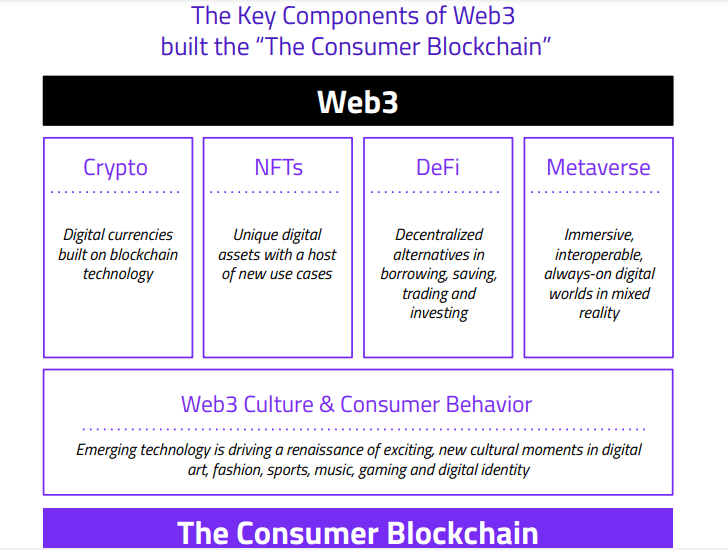
Courtesy: Vayner3
However, let's walk along with an intuitive trending report by Vayner3, a web3 consultancy run by Gary Vaynerchuk. They published a report on web3 trends for enterprises. It focuses on the following top curves and core points in the trending Web3 Industry.
1. Top-notch Brands
Big brands are soberly ahead with the strategies to take the Web3 benefits.
The report shows, in late 2021 and early 2022, hundreds of consumer brands joined the Web3 movement, abandoning NFTs, adopting the metaverse, and investigating fresh blockchain use cases.
What worked for these early leaders probably won't be the same in 2023 because the brand entry strategy in Web3 is constantly changing.
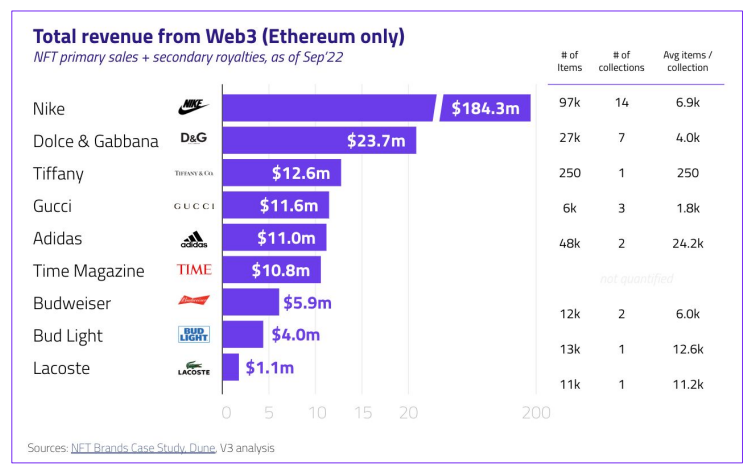
Source: Vayner3
However, Vayner3 observes the winners' careful, methodical approach, with a focus on long-term platform development. And they trust the following three actions to bring success to brands in 2023:
(a) provide straightforward Web3 products,
(b) seek detailed consumer targeting, and
(c) establish deliberate go-to-market strategies.
2. Big Tech Companies
Big Techs are bringing tons of audience to Web2.5
Vayner3 refers to this mix between Web2 and Web3 as Web2.5 since major tech businesses are incorporating tokens based on blockchains into their primary product offerings.
Amazon, Google, Instagram, Microsoft, Reddit, Shopify, and many other Web2 players are all testing the waters for Web3. These enormous organizations frequently "experiment" by focusing, investing, and operating at scales that are worth millions of dollars.
Vayner3 states, although Microsoft and Google have already entered the 9 to 10-digit range with conservative estimates showing $500M and $1.5B spent in Web3 technology, respectively, Meta is the early leader in Web3 investments with approximately $10B invested in its metaverse technology.
3. Cryptocurrency
Crypto payment gets its bona fide acceptance in the Web3 industry.
Recent years have seen a sharp increase in the use of cryptocurrencies worldwide, with conservative predictions placing the number of users at around 300 million by the beginning of 2022.
1. Coinbase: Over the past two years, crypto exchange and investment platforms like Coinbase have steadily attracted 5 to 15M new verified members per quarter.
2. Reddit Influence: 3 million additional users of digital wallets have been added as a result of Reddit's recent entry into web3 technology trends.
3. Instagram: Instagram just revealed that its 160 million US users will be able to create, sell, and trade NFTs as part of its most recent pilot program.
Thus, this innovative and fascinating area of the Web3 internet is expanding significantly.
4. Token Tickets
The use of token tickets brings in fresh new business models.
Vayner3 typically learns about the drawbacks of experiential activations from their enterprise partners.
These drawbacks include the lack of opportunities for data collection or long-term connections, problems with impact assessment, and a lack of connections between the activation and a more comprehensive campaign strategy. They believe that digital tokens offer a strong value driver to overcome these obstacles.
Although notable statements from companies like Ticketmaster and the NFL have been made, Vayner3 believes that 2023 may not be the year that blockchain-based tickets become widely used.
However, in 2022, they observed early evidence for a variety of experiential use cases that prompted improved IRL activations, deeper consumer engagement, and new avenues for retargeting and post-event community building.
So, they anticipate that these early prototypes will gain significant traction in 2023, particularly during the summer conference and festival season.
5. Web3 Mobile
Growing competition for Web3 mobile.
After all of this, the mobile world might actually become a Web3 battleground in 2023. Recent regulatory changes by Apple have an impact on how Web3 app developers can distribute and make money from their Web3 apps in the Apple App Store.
Vayner3* report says, in addition to OEMs like HTC launching Web3-capable handsets recently, blockchains like Polygon and Solana have both announced mobile agreements and investment in 2022. 15 These latest news, in our opinion, are just the start of a conversation about Web3 mobile in 2023.
6. Metaverse
The Metaverse is yet on the long way of its starting to reach the apex.
Google Trends US Search Interest for “Metaverse” shows January 2-8, 2022 was the peak, then slowly started declining and reached at 17 from 100 on 17th of Dec 2022.
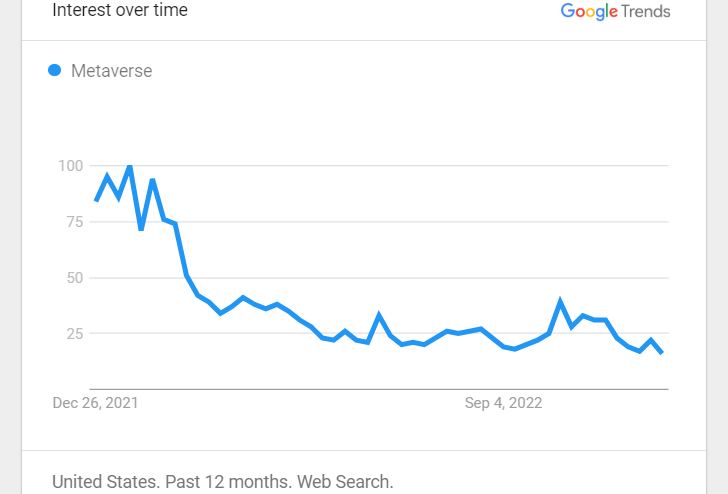
Metaverse Search Interest in the USA
Although Roblox and Fortnite are widely known as "metaverse platforms," their user bases have not yet reached the buying age. They both have the most daily active users in the market, but the majority of their user bases are young people. According to the Vayner3* report, 54% of Roblox users are under the age of 13, and over 86% are under 25.
7. Multi-chain Feature
Multi-chain Feature is the future for enterprises.
Every blockchain differs from one other in how it addresses key issues like security, transaction costs and speeds, and Tokenomics. However, Vayner3 observed that business collaborations, and cultural and brand consequences are becoming more significant.
With stunning announcements involving Reddit, Disney, and Instagram, Polygon has set a standard for common use cases.
Due to its connections with the NBA, NFL, and Ticketmaster, the Alternate Layer 1 blockchain Flow has remained one of the top chains in sports. Given the stated focus on games and connectivity with the Gamestop NFT platform, Immutable X might be the chain for gaming.
8. Jobs on the Web3
The Web3 Jobs are increasing across disciplines.
Web3 is not just for engineers and developers, according to Vayner3. Web3-focused businesses require a cross-functional workforce due to rising funding, corporate involvement, and consumer demand.
According to the report, just 26% of Web3 job posts in 2020 were for non-technical blockchain professions like marketing, management, human resources, and so forth. By 2021, however, this category had increased to 39%. Therefore, the Vayner3* anticipates that this trend will persist when Web3 technologies are broadly commercialized.
The Beginners FAQ
What is Web3?
As a beginner, you may ask about Web3 - what is it? Using ideas like decentralization, blockchain technology, and token-based economics, Web3 proposes a new version of the World Wide Web.
What is Web3 Technology?
Then, may arise, what do you mean by Web3 technology? Yes, web3 technology includes Blockchain, AI, and machine learning. They are all used in Web 3.0. It should result in genuine conversation. The data will belong to the individuals, and they will be paid for the time they spend online.
What is the relationship between Web3 and Blockchain?
Also, be notable, does the blockchain belong to Web3? The answer is yes. Web3 is a cryptocurrency extension that uses blockchain in novel ways to achieve novel goals.
A blockchain can be used to store information such as the number of tokens in a wallet, the terms of a self-executing contract, or the code for decentralized software.
What is the reason your company needs web 3.0 Technology?
The acute reason is that businesses will become more transparent and customer-focused with web 3.0 technology. Everything that was wrong with the way companies handled customer data will change drastically.
How will businesses use the new online features is the key question. The answer is that Blockchain and the opportunities it presents will be welcomed by both established and new firms. You may integrate blockchain technology into your apps to make all data open to the public.
Where I Can Learn Certified Web3 Technology?
Blockchain Council is the best ideal platform to learn Web3 Technology with valid certification for superior professional skills. Because they collaborate with the best technology experts and instructional designers around the globe and provide certification courses coupling all aspects of Blockchain and Web3 base. Now this organization is the leader of the world for Blockchain-based Web3 Technology.
Certified Web3 Expert™ is a set of five major Web3 certifications: Certified Blockchain Expert™, Certified Ethereum Expert™, Certified NFT Expert™, Certified Metaverse Expert™ & Certified Mixed Reality Expert™.
Course Duration: 30 Hours, Certification Validity: Lifetime, Exam: Online, Access Mode: Self-paced.
FYI, you have a chance to save up to 30% on all certifications! Use coupon code EOY20 to save 20% sitewide or COUNCIL30 to save 30% on two or more certifications.
Conclusion
The Web3 technology trends may help you determine your future enterprise today, and hone your dream with a competitive edge. Because web3 is a futuristic tech umbrella that enables organizations to expedite processes by removing the intermediary and connecting computers directly.
This makes it easier for all parties such as workers, partners, and buyers to communicate and work together, which improves a corporate skills.
Some of the most common use cases of Web3 include accessing financial services utilizing a non-custodial wallet, playing blockchain games, and earning remote online income.
So, the future web3 edition of the internet might decentralize any currently centralized platforms.
Love to Upskill
Web3!
If you are ready to invest in your future with Web3 Technology to dominate in the industry, Blockchain Council Certifications are unbeatable leverage to grab your opportunity to save big on upskilling your potential ability this time.
With Code COUNCIL30, avail sitewide 30% off on purchasing two or more certifications. If you need only one certified course, enjoy 20% off on the purchase with Code EOY20.
Become a Certified Web3/Blockchain/Metaverse Super Skill! 50,000+ Professionals certified so far by Blockchain Council. Keep upskilling your dream nearest future today.

